| Scientists at Nanoprobes, Inc. are heralding a major breakthrough in cancer research, using their new magnetic nanoparticles. After a quick intravenous injection and just three minutes inside a magnetic field, 80% of their test animals are completely cured of cancer. Their spectacular results have just been published in The International Journal of Nanomedicine. |
VIDEO: Learn how it works from Nanoprobes scientists
Dr. James F. Hainfeld and Hui Huang.
|
The concept behind their work is deceptively simple. When an iron particle is put inside an alternating magnetic field, it will spin back and forth and generate significant heat. If many iron particles were delivered to a tumor, you could actually cook the cancer; heat therapy, or cancer hyperthermia, works on this principle.
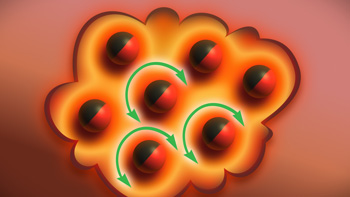 Iron particles inside a tumor spin in an alternating magnetic field, generating enough heat to cook the cancer.
The theory is solid, but the science was tricky. Researchers around the world had been trying to get this to work for many years, but without real success. Still, the idea was a good one, and in 2007, a scientist at Nanoprobes, Inc. decided to see if he could crack the problem.
Dr. James F. Hainfeld, PhD is a senior scientist, his world bridging biology, physics and chemistry. Although he hedges humbly, he is in fact one of the original fathers of the nanoparticle, engineering some of the very earliest under an electron microscope at Brookhaven National Laboratory in the 1970s. Now at his own laboratory, an intense gaze belies his easy smile; he's on a quest to cure cancer. "No one should ever have to hear, 'There's nothing more we can do,'" he says.
Dr. Hainfeld could see that a major problem here was the amount of iron needed for magnetic heating. A little in a multi-vitamin is helpful, but the amount needed for cancer therapy would be poisonous.
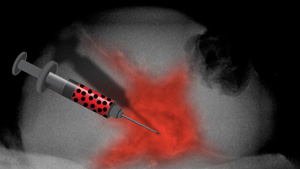 Previous attempts to directly inject tumors with iron particles would reach only portions of a tumor. To limit whole-body exposure, researchers had tried injecting iron particles directly into tumors. But even careful mapping and multiple injection points will miss some areas, and the cancer would always return. A German research group had even tried this method in people, but they sadly encountered the same difficulty.
As Dr. Hainfeld looked at the issues, his long experience in nanoparticle engineering helped him to reframe the problem. They didn't just need a better method of injecting iron; they needed to change the iron particle itself. If it could be made non-toxic, shielded from the body in some way, they could leave the limitations of direct injection behind.
In the Nanoprobes lab, Dr. Hainfeld asked a young, gifted student named Hui Huang to join him. A recent immigrant from China, his hardworking family wanted him to join their restaurant business; Huang, however, had a yearning for science.
Together, student and senior scientist would spend six years on the project, doggedly chasing their iron nanoparticle. The intense apprenticeship in nanoparticle synthesis and tenacious, out-of-the-box thinking would blossom just a few years later, when Huang himself solved the biocompatibility problem.
The pair could see their progress, but the idea seemed like a lost cause to the usual funding institutions, and their grant applications were continually rejected. Meager support would only come from the laboratory's modest sales, to other scientists, of nanoparticles useful in research.
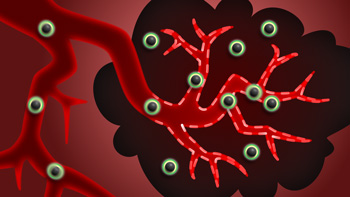 Leaky new blood vessels in cancers allow magnetic nanoparticles to accumulate in tumors, but stay out of healthy tissue. As they worked, the two discussed possible methods of delivery to a tumor. A natural property of cancer stood out to them: Enhanced Permeability and Retention, or EPR.
Since tumors are growing, they call on the body to create lots of new blood vessels, in and around them. New blood vessels, it turns out, are leaky; they allow anything of a certain size to pass through from the blood, and accumulate in a tumor. Healthy tissue, on the other hand, has mature blood vessels, so particles of this size will simply flow past.
A big part of the solution was in sight: if they sized their particle correctly, a simple injection into the bloodstream would let their particles find their own way into cancerous tissue, wherever it was found in the body. Even metastasized cancer would become a target.
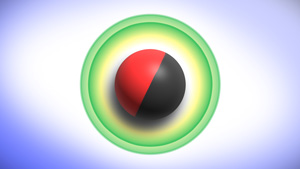
Nanoprobes' non-toxic magnetic nanoparticle, with an iron core and a biocompatible shell. When their nanoparticle finally stood ready for testing, it was perfectly sized, had a core of iron, and sported a biocompatible shell, with long polymer strands to keep it out of the liver and in the blood. The iron center could still spin and create heat in a magnetic field, but its coat sealed the iron safely away from the body.
After a simple injection into the bloodstream, their test animals stayed healthy; they had evaded the dreaded iron toxicity. And just as they'd hoped, the tumors accumulated high levels of the particles, with sixteen times the concentration of adjacent healthy tissue. They now had the necessary amount of iron inside the tumors for magnetic heating to work.
The final step was to put their test animals in a rapidly alternating magnetic field. Watching with an infrared camera to measure temperature, they saw the iron-laden tumors rocket to lethal temperatures, while the surrounding, healthy tissue stayed cool and unharmed.
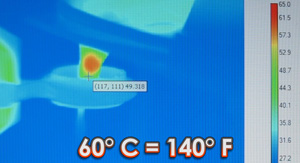
An infrared camera shows iron particles heating a tumor to liquefication, while adjacent healthy tissue stays cool and unharmed. After a single, three-minute treatment, the tumors were completely eradicated, with a precision finer than a surgeon's knife.
The tumors actually liquefied under such high heat, allowing the body to quickly absorb the neutralized remains. Within a few days, the animals were back to normal, and able to live the rest of their natural lives, cancer-free. And all that toxic iron? The nanoparticles are very stable and break down slowly; the body can process the small amounts released over time.
After much testing, Huang and Hainfeld have achieved a reliable, actual cure rate of 78-90% in mice, a very rare number in cancer research. Their results have just been published in The International Journal of Nanomedicine.
Their success is also great news for combination therapy, where pre-treating with heat therapy greatly increases the efficacy of both chemotherapy and radiation. So far, it's been difficult to heat deep tumors, but magnetic heating is perfect for this, since the nanoparticles can deliver themselves anywhere in the body.
The pair are also enthusiastic about their preliminary results with in vivo brain cancer, tested in collaboration with Dr. Henry Smilowitz at the University of Connecticut Health Center. Because blood filtering by normal brain tissue excludes even more of the particles, they've achieved a razor-sharp concentration ratio at the edge of a brain tumor. During magnetic heating, this precision would critically spare healthy brain matter, in contrast to the collateral damage of surgery or radiation.
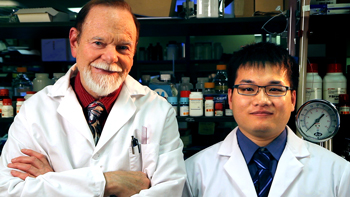
Dr. James F. Hainfeld (L) and Hui Huang in the Nanoprobes lab. The next steps are very exciting for Dr. Hainfeld and Huang. Their work has now been recognized by the National Institutes of Health, which recently granted them roughly a million dollars' worth of laboratory testing, in preparation for FDA approval. "We need to bring this to patients, as soon as possible," says Huang, now in medical school and soon to be treating patients himself. Nanoprobes is currently organizing funding for the clinical trials to come.
"After so many years in the trenches, I tend to be cautious," says Dr. Hainfeld, "but I've never seen such promising results. We're very hopeful." He smiles, then returns to his work: the quest continues.
Contact: Dr. James F. Hainfeld, PhD
Email: hainfeld [at] nanoprobes.com
Nanoprobes, Inc. is a nanoparticle research collaborative, dedicated to finding cures for cancer and other diseases. Our technology is helping save lives around the world, as the core of the HER2 breast cancer test. Located in Yaphank, NY, our funding comes from research grants, and sales of nanoparticle products to the scientific community; all profits support our research.
Read the scientific paper online, available free (open access):
Intravenous magnetic nanoparticle cancer hyperthermia
Huang HS, Hainfeld JF. International Journal of Nanomedicine. 2013:8, 2521-2532.
Nanoprobes is looking for funding partners as we prepare for the FDA approval process.
Please let us know if you would like to join this very important project.
Please understand that this treatment is currently being tested in animals, but there are no clinical trials available at this time.
Learn more about the future of clinical trials with magnetic nanotherapy, and where to find help
in the meantime. |